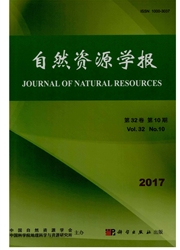

 中文摘要:
中文摘要:
农村发展态势评价与驱动力分析,是乡村地理学研究的重要内容。论文通过构建农村发展态势评价指标体系,应用因子分析方法和驱动力指数模型,开展了我国东部沿海地区农村发展态势评价与驱动力分析。结果如下:①1990年农村发展水平普遍比较落后,2000年农村发展总体格局基本形成,2005年各地区普遍进入中等以上发达水平,但区域差异进一步拉大,长江三角洲、珠江三角洲地区农村发展呈面状辐射扩散态势;②除人均耕地面积、单位播种面积农业机械总动力外,其他指标均为农村发展的积极推动因素,尤以农民人均所得指标为最;③今后应借助工业化、城镇化的外部动力和农村自我发展能力的合力助推,倡导资源节约集约利用与生态环境保护意识,注重农村劳动力资源的培育与引进,既要进行农村产业升级,强化非农产业发展,又要加快现代农业建设。
 英文摘要:
英文摘要:
Nowadays, agriculture and rural area in our country are in the period of transition and development. It is very necessary to carry out research on rural and agricultural development to grasp their trends, spatial pattern characteristics and driving forces for relevant decision making. Based on the rural geographical theory, the rural development state includes two parts, namely the rural development ability and the rural development condition. According to these, the evaluation indicator index system of rural development state was built. In this paper, the factor analysis method and the driving force index model were proposed to evaluate the rural development state and analyze driving force in 1990, 2000 and 2005 in eastern costal China on the county scale. The results are as follows : 1 ) In 1990, most of the rural areas are undeveloped. In 2000, the pattern of regional rural development has been coming into being. In 2005, most of the areas are on the developed level, but the regional difference has been enlarged. The rural areas in the Yangtze River Delta and the Pearl River Delta are very well developed and are driving the surrounding areas. 2) All of the indictors are the positive factors in the process of rural development in the past years, except the farmland area per capita and agricultural mechanical total powers unit sowing area. The driving index of the farmer per capita incoming is the largest, which is 0. 0949, and the agricultural productive efficiency indictor is in the second place, which is 0. 0876. 3 ) In the future, the composition of the rural development inner ability and the exterior drive of urbanization and industrialization are the main driving force of rural development. And the resources intensive use and environmental protection, rural labor resources training and talent introduction, all should be strengthened. In order to promote the rural economic sustainable and healthy development, the rural non-agricultural industries development should be accelerated by means of industr
 同期刊论文项目
同期刊论文项目
 同项目期刊论文
同项目期刊论文
 Farmland Destroyed by Natural Hazards in China: Spatio-temporal Pattern and Integrated Prevention an
Farmland Destroyed by Natural Hazards in China: Spatio-temporal Pattern and Integrated Prevention an Industrial development and land use/cover change and their effects on local environment: A case stud
Industrial development and land use/cover change and their effects on local environment: A case stud Characteristics and mechanism of agricultural transformation in typical rural areas of eastern China
Characteristics and mechanism of agricultural transformation in typical rural areas of eastern China Analysis of urban-rural land-use change during 1995-2006 and its policy dimensional driving forces i
Analysis of urban-rural land-use change during 1995-2006 and its policy dimensional driving forces i Differentiation of rural development driven by industrialization and urbanization in eastern coastal
Differentiation of rural development driven by industrialization and urbanization in eastern coastal Dynamic evolvement of agricultural system and typical patterns of modern agriculture in coastal Chin
Dynamic evolvement of agricultural system and typical patterns of modern agriculture in coastal Chin Spatio-temporal dynamic patterns of farmland and rural settlements in Su-Xi-Chang region: Implicatio
Spatio-temporal dynamic patterns of farmland and rural settlements in Su-Xi-Chang region: Implicatio Land Use Changes of an Aeolian-Loessial Soil Area in Northwest China: Implications for Ecological Re
Land Use Changes of an Aeolian-Loessial Soil Area in Northwest China: Implications for Ecological Re Spatio-temporal patterns of land use change in typical transect area along China National Highway 10
Spatio-temporal patterns of land use change in typical transect area along China National Highway 10 Urban ecological security assessment and forecasting, based on a cellular automata model: A case stu
Urban ecological security assessment and forecasting, based on a cellular automata model: A case stu 期刊信息
期刊信息
